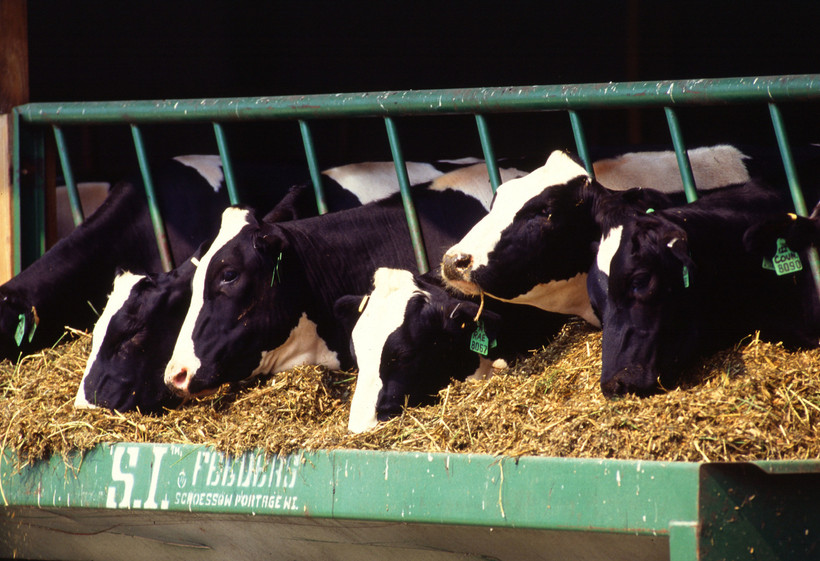New York Dairy Farms Skirt Clean Water Act Requirements
Farms in New York have used a form of legal arbitrage to shield their manure management practices from scrutiny.

This article was co-published with The American Prospect.
New York is a top exporter of milk, cottage cheese, and dairy products. Playing to multiple galleries, Governor Andrew Cuomo has championed vigorous production of Greek yogurt, designating it as the official state snack, convening a Yogurt Summit, and boasting that New York makes more Greek yogurt than Greece.
The push to revitalize dairy has worked: New York is host to more than 600,000 dairy cows at more than 4,000 dairy farms, in a sector that has consolidated as it has grown. Concentrated Animal Feeding Operations (CAFOs), industrial facilities dwarfing family-run farms, are more numerous. The number of dairies with more than 1,000 cows doubled between 2007 and 2017. And as in other states, they have fiercely guarded information about their operations.
So environmentalists cheered what seemed like a big win in 2018, when New York’s Supreme Court ruled, over the objections of the state Farm Bureau, that large farms must make their pollution-handling practices available for public review. The new requirement to disclose details about how farms deal with animal waste and runoff was expected to apply to about 250 industrial facilities in New York.
But today, not a single farm is registered under that stricter requirement, an investigation by New York Focus and the Prospect found. Instead, hundreds of farms have switched to a state permit under which manure management practices are not subject to public review.
Without forcing the release of better information, environmentalists argue, lawmakers will continue to underestimate the threat of livestock pollution and carbon emissions from agriculture.
Where has dairy farms’ discharge gone?
An average lactating cow produces more than 100 pounds of manure each day. That number scales fast: a 950-cow farm can produce as much sewage as the city of Albany.
But instead of being piped to a sewage plant for treatment, cow waste is stored until it can be spread on fields. Manure is a healthy fertilizer when applied in quantities that the ground can soak up, but is often overapplied, environmental experts say, sinking into the soil where it can leach into underground pipes. Storms can also breach storage tanks, and can cause manure to contaminate waterways.
In recent years, New York has seen a rise in toxic blooms of fluorescent blue-green algae, which blanket lakes in thick cyanobacteria and can suffocate aquatic ecosystems. The algae feed on nutrients such as phosphorus and nitrogen which flow into water from farm runoff, threatening drinking water and tourism.
Rural New Yorkers have also seen an uptick in dramatic leakage events, such as a 75-by-25 foot plume of liquid manure in a lake that provides drinking water for 44,000 residents of Central New York. An incident in March of this year saw 100,000 gallons of manure overflow from a storage pit, some of which discharged into nearby water.
The Clean Water Act (CWA) requires facilities that discharge wastewater, like large meat farms, to obtain a permit detailing their protocols, to prevent these outcomes. This law is mostly administered through the states, which write their own CWA-compliant version of the permit.
States also have the ability to issue additional permits. That allows them to go above and beyond EPA guidelines. But it can become a way of sidestepping federal standards.
New York issues both a CWA permit for CAFOs that discharge pollutants, and an alternative permit for CAFOs that do not discharge, issued under the state Environmental Conservation Law (ECL).
Prior to a lawsuit by environmental groups, both permits were enforced by private, farm-hired consultants, and limited public review.
In 2017, environmental groups including Riverkeeper and Earthjustice sued the state Department of Environmental Conservation (DEC), arguing that the Clean Water Act required farms to make detailed nutrient management plans available for public review. The court sided with them, agreeing that the consultants who crafted and then certified pollution management plans posed an “inherent conflict of interest.”
In response, the DEC issued a stricter Clean Water Act permit. But instead of complying with new rules, around 250 dairies have switched to the state ECL permit.
Prior to the lawsuit, about half of New York’s roughly 500 CAFOs were permitted under the CWA, and half under the ECL.
Today, not a single CAFO in New York is permitted under the CWA permit, the DEC confirmed. Currently, the agency said, 484 CAFOs are permitted under the ECL permit.
Instead of winning more transparent disclosure for mega-dairy farms that had been permitted under CWA, then, environmentalists perversely now find that they have less insight into farms’ manure management.
“Everyone funnels into a less protective state program”
New York’s Department of Environmental Conservation argues that the state ECL permit is actually stronger than the CWA.
Environmentalists agree, in theory. “The idea of having a state permit is a good one,” said Alexis Andiman, an Earthjustice attorney who worked on the case. Not all farms are captured under the Clean Water Act, so a state permit can go above those minimal regulatory guidelines.
“The problem is the way it functions,” she said. “In practice, you end up with situations like this, where very few CAFOs—or zero, in this case—are willing to admit that they discharge. So everyone funnels into a less protective state program that really isn't designed to regulate discharging facilities.”
The DEC disputed that characterization, maintaining that the facilities now certified under the ECL do not discharge. The agency does not require large CAFOs permitted under the ECL to submit an annual nutrient management plan.
“The State’s CWA and ECL permits required, and continue to require, technical requirements far more restrictive and protective than those offered by federal regulations,” the DEC said in a statement. “Although the ECL permit does not require the certified, independently generated nutrient management plans be submitted to DEC, New York State requires the submission of other documents and reports which are publicly available upon request.”
CAFOs must develop procedures for dealing with wet weather overflows to prevent discharges even in a 100-year storm event—a higher threshold than the CWA requires. But those plans are still certified by a private consultant, rather than a DEC inspector.
Peter Wright, an agricultural engineer at a Cornell University dairy program, said in an interview that farms ought to be offered more privacy from meddlesome neighbors.
“Nobody has a pipe out to a stream,” Wright said. “What the state said is, well, you farmers have put in all these practices. In essence, you're not discharging.”
“If I’ve got to go to the public and do a public review, every time I make a change, it's just, you know, it’s a headache. Besides just the fact that now, they're in my business,” Wright said. “Who in the public, even those advocates, have enough knowledge to actually understand my plan?”
In response, Andiman pointed to water contamination throughout the state, such as algal blooms, and local reports of discharge, as evidence that the “mass exodus” of CAFOs from the CEA is an effort to evade scrutiny while continuing with potentially polluting activities.
“It’s very unlikely that hundreds of CAFOs would suddenly stop discharging water pollution, just as water pollution permits became more stringent,” Andiman said. “Making that kind of change would require pretty significant design changes, or significant reductions in the number of animals being confined.”
Lawmakers have also questioned the ECL. Assemblymember Anna Kelles called the permit “a statutory fiction that presumes zero pollution” in a recent comment on harmful algal blooms in her district.
Agribusiness has weaponized federalism
The legal regulation of CAFOs hinges on the definition of “discharge,” which has been diluted through decades of legal battles, a recent Natural Resources Defense Council report shows. As a result, farms in other states may also be evading the requirement to operate under a Clean Water Act permit by claiming that they do not discharge. The burden often falls on the public to show otherwise.
“The government must demonstrate that a CAFO is discharging into waters if it wants to compel the facility to apply for a permit—a difficult task, especially if the EPA does not even know that the CAFO exists,” NRDC writes.
Agribusiness lobbies in other states have also weaponized the EPA’s delegated permitting structure, said Hannah Connor, an attorney with the Center for Biological Diversity.
For example, Idaho, the latest state given the power to administer its own CWA permit, created a standard that is already in dispute. Oregon, which has seen a boom in mega-dairies in recent years, requested a delegation of CWA permitting authority for its environmental agency. Then, that agency in turn delegated permitting to the Department of Agriculture. That has led to regulatory capture, environmental groups argue, due to the department’s split mandate to police and promote agriculture.
The EPA’s granting discretion to states hasn’t been all bad: It has allowed for stricter protections in some places, Conner said. But the bifurcated structure has created a scattershot and easily exploited set of requirements.
“States have by and large made things less transparent and harder to work with than if we had a really strong federal minimum,” Connor concluded.
Exempting farms from scrutiny
Public review isn’t just a concern for local government wonks and busibodies.
Exempting farms from public oversight is a broader trend that allows pollution to continue unchecked. Waxman-Markey, the signature Obama-era push for climate regulation, exempted factory farms from reporting greenhouse gas emissions. (Despite the carveout, the bill never passed). The Trump EPA weakened already-lax requirements to report farm air emissions.
“Congress’s focus when passing the Clean Air and Clean Water Act in 1970 was on very visible industrial pollution,” said Earthjustice’s Peter Lehner. “At that time, agriculture was much more predominantly small farms, where Congress could reasonably think regulation doesn’t make sense. There wasn’t an end-of-pipe like there was a smokestack or factory discharge.”
As a result, even climate hawkish elected officials reach for agriculture emissions as a political bargaining chip—a lower-priority sector than the electric grid or passenger vehicles.
In New York, the ambitious Climate Leadership and Community Protection Act entirely omits emissions from livestock, even as fossil fuel companies and other major polluters were told they must wind down carbon-intensive operations in the state. Livestock emissions represent a small share of New York’s emissions, but remain poorly understood.



